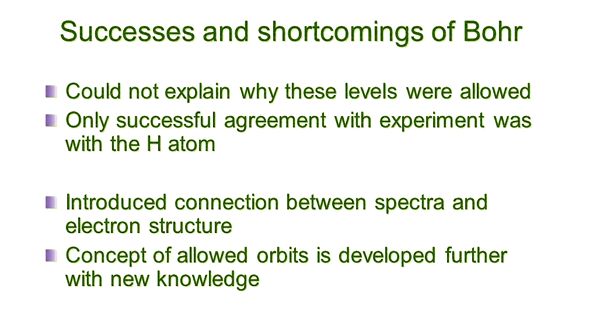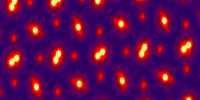The shortcoming of Bohr’s Theory
Bohr’s theory was able to explain successfully a number of experimental observations and has correctly predicted the spectral lines of the hydrogen atom. It doesn’t explain about the energy of an atom and its stability. The most serious drawback of the model is that it is based on two conflicting concepts. According to this model, the state of equilibrium is determined by absolute rules while emission is interpreted on the basis of quantum theory. However, the theory fails in the following aspects.
(a) The first wrong assumption made by Bohr is considering the electron orbiting around the nucleus in a circular orbit, however, we know now that this is not correct, because electrons exist in a cloud.
(b) The theory could not account for the spectra of atoms more complex than hydrogen.
(c) The theory does not give any information regarding the distribution and arrangement of electrons in an atom. This theory can only explain the spectrum of hydrogen and hydrogen-like atoms. It is unsuccessful to explain the spectrum of complex atoms.
(d) It does not explain, the experimentally observed variations in the intensity of the spectral lines of the element. The bore theory interprets only the wavelengths of the spectrum lines, does not explain the variation of their intensities, that is, does not give any information regarding the wave nature of the electron.
(e) When the spectral line of a hydrogen atom is examined by spectrometers having high resolving power, it is found that a single line is composed of two or more close components. This is known as the fine structure of spectral lines. Bohr’s theory could not account for the fine structure of spectral lines.
(f) It failed to explain the Stark effect when the spectral line gets split up into fine lines in the presence of an electric field. It is found that when an electric or magnetic field is applied to the atom, each of the spectral lines split into several lines. The former effect is called as Stark effect, while the latter is known as the Zeeman effect. Bohr’s theory could not explain the Stark effect and the Zeeman effect.
Bohr model is valid only for hydrogen since it has one electron only, however, when it was applied to other elements, the experimental data were different than the theoretical calculations. This principle is unable to explain the effect of the magnetic field on the spectrum lines and the effect of the effects of the effects of the spin-back effects and the effects of the field.














